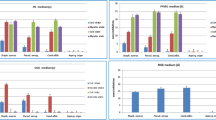Abstract
Cyanobacterial cultures tolerating 200 mmol l−1 sodium chloride isolated from terrestrial and freshwater habitats of North Maharashtra region of India were evaluated for antifungal activity. Aqueous, methanol, n-propanol, and petroleum ether extracts of 40 cyanobacterial isolates belonging to nine genera were examined for inhibitory activity against five fungal pathogens. Eighteen isolates belonging to genus Oscillatoria dominated the population of halotolerant cyanobacterial cultures. Four antifungal bioassays viz. double layer agar method, disc diffusion assay, silica gel method, and minimum inhibitory concentration (MIC) were used to screen the cultures for antifungal activity. Among the solvents used, methanol extracts showed 34.9% inhibition followed by n-propanol, petroleum ether, and water exhibiting 30.2%, 18.6% and 16.2% inhibition, respectively. The double agar layer method was found to be a suitable method in preliminary screening for handling large number of cultures without extraction of compounds. However, in later screening experiments, silica gel method was seen to be advantageous over MIC and agar disc diffusion methods.



Similar content being viewed by others
References
Castenholz RW, Waterbury JB (1989) Oxygenic photosynthetic bacteria, group I. Cyanobacteria. In: Staley JT et al (eds) Bergey’s manual of systematic bacteriology. Williams and Wilkins Co., Baltimore, pp 1710–1720
Chetsumon A, Maeda I, Umeda F, Yagi K, Miura Y, Mizoguchi T (1994) Antibiotic production by the immobilized cyanobacterium, Scytonema sp. TISTR 8208, in a seaweed-type photoreactor. J Appl Phycol 6:539–543
Desikachary TV (1959) Cyanophyta. Indian Council of Agricultural Research, New Delhi
Ghazala B, Shameel M (2005) Phytochemistry and bioactivity of some freshwater green algae from Pakistan. Pharm Biol 43:358–369
Kaushik BD (1987) Laboratory methods for blue-green algae. New Delhi Associated Publishing Company, New Delhi
Kaushik BD (2007) Cyanobacteria for amelioration of salt affected soils. In: Somani LL, Bhandari SC (eds) Organic recycling and bioinoculants for sustainable crop production. Agrotech Pub Academy, Udaipur, pp 308–323. ISBN 818321066X
Mian P, Heilmann J, Bürgi H-R, Sticher O (2003) Biological screening of terrestrial and freshwater cyanobacteria for antimicrobial activity, brine shrimp lethality, and cytotoxicity. Pharm Biol 41:243–247
Olaizola M (2003) Commercial development of microalgal biotechnology: from the test tube to the marketplace. Biomol Eng 20:459–466
Ördög V, Stirk WA, Lenobel R, Bancířová M, Strnad M, van Staden J, Szigeti J, Németh L (2004) Screening microalgae for some potentially useful agricultural and pharmaceutical secondary metabolites. J Appl Phycol 16:309–314
Østensvik Ø, Skulberg OM, Underdal B, Hormazabal V (1998) Antibacterial properties of extracts from selected planktonic freshwater cyanobacteria—a comparative study of bacterial bioassays. J Appl Microbiol 84:1117–1124
Quiroga EN, Sampietro AR, Vattuone MA (2004) In vitro fungitoxic activity of Larrea divaricata cav. Extracts. Lett Appl Microbiol 39:7–12
Rahmani M, Ling CY, Meon S, Ismail HBM, Sukari MA (2004) The antifungal activity of Glycosmis calcicola and G. rupestris extracts. Pharm Biol 42:430–433
Robles Centeno PO, Ballantine DL (1999) Effects of culture conditions on production of antibiotically active metabolites by the marine alga Spyridia filamentosa (Ceramiaceae, Rhodophyta). I. Light. J Appl Phycol 11:217–224
Schlegel I, Doan NT, de Chazal N, Smith GD (1999) Antibiotic activity of new cyanobacterial isolates from Australia and Asia against green algae and cyanobacteria. J Appl Phycol 10:471–479
Singh S, Kate BN, Benerjee UC (2005) Bioactive compounds from cyanobacteria and microalgae: an overview. Crit Rev Biotechnol 25:73–95
Skulberg OM (2000) Microalgae as a source of bioactive molecules-experience from cyanophyte research. J Appl Phycol 12:341–348
Soltani N, Khavari-Nejad RA, Yazdi MT, Shokravi S, Fernández-Valiente E (2005) Screening of soil cyanobacteria for antifungal and antibacterial activity. Pharm Biol 43:455–459
Volk R-B (2005) Screening of microalgal culture media for the presence of algicidal compounds and isolation of two bioactive metabolites, excreted by the cyanobacteria Nostoc insulare and Nodularia harveyana. J Appl Phycol 17:339–347
Acknowledgments
The authors are grateful to Hon’ble Vice-Chancellor, NMU and Prof. Chincholkar, Director, School of Life Sciences for providing necessary facilities for the study. Mr. Sunil Pawar is grateful to UGC, New Delhi for providing Teachers Fellowship under FIP and also, thankful to the Principal, T.C. College, Baramati, India for constant help in the research period.
Author information
Authors and Affiliations
Corresponding author
Rights and permissions
About this article
Cite this article
Pawar, S.T., Puranik, P.R. Screening of terrestrial and freshwater halotolerant cyanobacteria for antifungal activities. World J Microbiol Biotechnol 24, 1019–1025 (2008). https://doi.org/10.1007/s11274-007-9565-6
Received:
Accepted:
Published:
Issue Date:
DOI: https://doi.org/10.1007/s11274-007-9565-6




